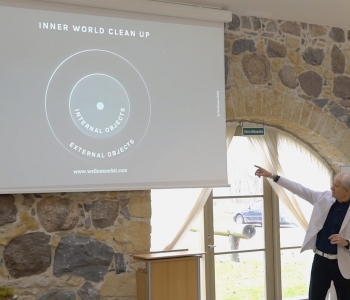Burnout is 100% preventable, you just need to train your mind while well
Are you aware that burnout is 100% preventable?
Burnout is a state where the internal drive fades and is replaced with exhaustion, cynicism, and a sense of ineffectiveness. It arises from prolonged and excessive stress, often feeling like an inevitable consequence of demanding work. As we have opened up, most burnout originates from positive stress.
Burnout is fully preventable when the context of employee mental wellness is focused on training intrapersonal skills and keeping a calm mind. We train our physical body when we are well, however, most of us don’t train our minds while we are well.
Have you taken time to train your mind and do you do it weekly? Have you ever trained your intrapersonal skills?
The path to burnout is slow and long. It is mostly the most dedicated professionals, known for their innovative contributions, passion and unwavering commitments that burn out the most.
High burnout rates are seen among healthcare workers (nurses, doctors, EMTs, mental health professionals), lawyers, IT professionals, teachers, social workers, emergency responders (police, firefighters), customer service providers, and journalists. However, this isn’t a complete list.
Common factors in professions where you see high levels of burnout include excessive workload, lack of control, insufficient rewards or salaries, poor social support, fairness and toxic workplace issues, values mismatch, and high emotional demands. Also, individual experiences and workplace conditions significantly influence burnout.
However, burnout is always due to stress and high pressure as people lack intrapersonal skills to handle processes in their inner domains.
No one without intrapersonal education is safe here. The foundation of the problem always is inner reactivity. Watch this video where Kaur Lass opens up the stress and burnout topic a bit closer.
Without practical intrapersonal skills, people are highly susceptible to stress and burnout. Long hours, emotional motivation, pressing deadlines, and the constant demand for groundbreaking work gradually erode well-being if you lack intrapersonal skills and the ability to respond consciously.
Reducing stress and burnout risk is now made easy
When a workplace prioritizes employee mental wellness proactively you can shift the narrative and get rid of the burnout problem.
When you learn and use intrapersonal skills and can ground yourself fully in the present moment you can handle pressure. It comes down to using consciousness in an active form that allows you to lead your awareness at will. Noticing the physical manifestations of stress and knowing how to reduce stress matters.
Observing your thoughts and imaginations and leading them with awareness gives you improved self-leadership. You no longer suffer from fixed ideas and fears.
When you also learn to let go of your negative emotions and lead your emotions at will you gain a lot more control over your life and no longer depend on automatic inner reactions.
Neuroscience confirms that when you train your mind to be less reactive to daily stressors and foster inner calm and resilience your mental wellness improves and stress levels drop. That is why mind health trainings that improve intrapersonal skills should be a standard in all workplaces.
We have opened up in our blogs that multitasking isn’t working and instead, you should use monotasking and time-blocking, where focused periods are dedicated to specific tasks, punctuated by short breaks.
Taking breaks and relaxing at work matters. Remember, pauses are vital for preventing mental fatigue and sustaining concentration when back to your task. Just as you relax muscles after a workout or heavy lifting, you also need to relax your mind.
Burnout is fully preventable when you monitor your stress level and reduce inner reactivity
Constantly tense muscles cause pain. A constantly tense and busy mind is worried, stressed and anxious. As 9 out of 10 people in the working age are stressed, it is correct to assume that most people lack both intrapersonal skills and inner wellness.
Do you know your current stress level? Burnout is preventable only when you reduce your stress level, so take the stress test, it is free and comes with feedback.
.jpg)
When we came out with the stress reduction and burnout prevention e-training 'Performing Under Pressure' we noticed that compared to our other e-trainings the first self-evaluation test is better than the last. We went out and asked why is this, and the result was a bit surprising even for us.
But it was logical. You evaluate your stress level and burnout risk at first based on what you know. Then you take the training sessions and quizzes as well as monitor yourself through the workbook and notice that your knowledge of stress is poor. So, when in the end you do the self-evaluation again, your evaluation becomes correct. This proves how little people are aware of their actual stress situations.
Most people have much higher stress and pressure levels and much less knowledge about preventing burnout than they should. Most people have not learned to evaluate their actual mental wellness level and are afraid to establish healthy boundaries.
Even as simple thing as understanding that declining additional commitments is an act of self-care, not a sign of weakness can make a difference. When you prioritize your mental well-being and protect personal time and train your mind, your health improves.
Remember that dedicated time for rest and inner calmness, training your body and mind and calming hobbies and personal relationships are essential for replenishing your energy reserves.
Training your mind to achieve calmness is a consistent practice. Also, remember to regularly reflect on aspects of life for which you are grateful as it allows you to notice what is currently well in your life.
Championing employee mental wellness is a conscious choice
In a workplace that champions employee mental wellness, burnout isn’t viewed as a mark of dedication but as an indicator that an individual's needs are not being adequately met.
Proactive mental wellness needs to be implemented workplace-wide to restore equilibrium. When organizations prioritize employee well-being and offer resources for stress management and burnout prevention also employee engagement levels improve (see Gallup 2025 study image below).

Only when leaders recognize that a flourishing workforce is one that feels supported will they invest in securing mental wellness. The correct way to see investments in learning intrapersonal skills is that this investment improves both mental wellness and employee engagement levels.
The proactive reduction of burnout has a significant positive impact on overall mental health, substantially lowering the risk of depression.
While burnout and depression share some symptoms, such as fatigue and loss of interest, burnout is typically rooted in chronic workplace stress, whereas depression can have broader origins. However, the final phase of burnout and depression have 86% to 92% overlap.
By actively preventing burnout through stress management and cultivating a calm mind, a robust foundation of emotional resilience is built. This resilience serves as a protective barrier against the development of depressive symptoms.
Chronic stress, the precursor to burnout, disrupts the delicate balance of neurochemicals in the brain, including serotonin and dopamine, which are critical for mood regulation. As our earlier blogs have demonstrated many disorders originate from stress, especially if the stress is severe and prolonged.
By implementing stress-reduction techniques, the neurochemical balance is better maintained, fostering a more stable and healthy mood.
Furthermore, the feelings of inefficacy and cynicism associated with burnout can erode self-esteem and contribute to feelings of hopelessness, key characteristics of depression.
Preventing burnout cultivates a sense of competence and engagement, safeguarding against these negative thought patterns.
Conclusion
In a context where employee mental wellness is paramount, the understanding is clear: a calm and fit mind is not a perk but a fundamental requirement for a sustainable and fulfilling professional life.
By prioritizing mental well-being, individuals thrive both personally and professionally, demonstrating that burnout can indeed be 100% preventable within a supportive work environment and regular mind health training.
Burnout is fully preventable only when people have good intrapersonal skills. When you can monitor yourself and adjust your behavior and lifestyle choices, life can become less reactive and more proactive as you make conscious choices that keep you well and thriving.
Fostering a calm and supportive work environment becomes easy only when people in the workplace possess good intrapersonal skills.
This stress awareness month blog article is provided by Kaur Lass



